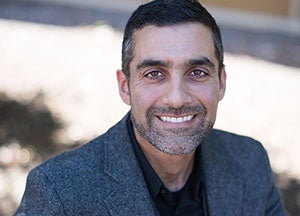Ask an Expert — What Have We Learned from Omicron?

This winter, the highly contagious omicron strain of COVID-19 swept across the world, reversing a growing feeling that the pandemic might finally be coming to an end. Now, as the omicron wave recedes, states across the nation have dropped mask and testing requirements and many seem ready to return to normal. But is it time to declare victory against COVID? Aydin Nazmi, who studies public health and epidemiology and serves as Cal Poly’s presidential faculty fellow for COVID response, weighs in on what we’ve learned from omicron and what might be coming next.
What was distinctive about omicron, compared to other variants we've seen so far?
Omicron has been the most genetically different from the original SARS-CoV-2, and that is one of the main reasons it has performed really differently in populations. It is much better at spreading itself around.
In an ecosystem, different organisms might be competing with each other for resources. Do different strains of COVID behave the same way? Did omicron “beat out” other COVID strains as it became more prevalent?
It’s not a perfect analogy, but it seems to be that way. Different variants have slightly different mechanisms by which to infect people. For example, omicron has a greater ability to evade vaccines than previous variants and is much faster at spreading through populations. As we saw an increase in omicron prevalence, we saw a concurrent decrease in delta prevalence, at least partly because of these reasons. Other factors such as human behavior and timing also play significant roles. Prevalence of the newer omicron subvariant BA.2, which is even more transmissible, is currently increasing around the world, displacing the original BA.1.

As the omicron spike seems to be just about over, where are we at in terms of the pandemic?
In the U.S., we are now at a level of about 30,000 known cases per day — but unknown infections are likely more prevalent than ever due to home testing — and about 1,100 deaths per day. This is about the same level of the first spike back in spring 2020. Globally, the statistics vary significantly based on place, but it is clear that the virus is still present and very much affecting the world’s health.
You may have heard the term ‘endemic’ flying around. Endemic simply means that the virus is here to stay forever. That is not good news, nor does it mean that the danger of COVID is done. To the contrary, that means we must remain as vigilant as ever. To some extent, we are better prepared now than ever before to confront new variants — for example by re-instating mask mandates, continuing vaccination efforts, and continually collecting and evaluating surveillance data. Luckily, clinical approaches to COVID have also improved dramatically, so people who get sick have a much better chance of survival if they have access to care and medicine. State, federal and local public health policies and strategies have to reflect the current and coming realities, and adjust accordingly, which is difficult given the public’s COVID fatigue.
We know new variants and new spikes could appear very suddenly and have a huge impact — just look at omicron. We know that COVID is now endemic, but it has also exhibited several significant epidemic phases. Being on the tail end of the largest epidemic phase to date, it is difficult to predict where we might be headed. Endemics can behave differently depending on season, like influenza, for example, that tends to be cyclical over the year. Additional factors such as human behavior and waning immunity are also relevant in the context of COVID.
Are there any other concerning variants that we should be keeping our eye on? And if so, what do we know about them?
At the moment, there are a two new ‘variants being monitored’ (VBM) that are delta- and omicron-like in terms of their genetic makeup. These are not currently considered “variants of concern” or “variants of interest” at this point, but this goes to show how dynamic and quickly-evolving the COVID situation remains.
One thing that almost anybody who has been working on COVID will tell you is that we have been surprised by this virus more than once. We thought delta was the big one, and omicron was not really predicted by anybody. And if you remember, after each of these waves that we've had, we thought, “Oh, that was huge. It's never going to be that bad again.” But each time, the next wave got progressively larger, so I think some element of humility on what the virus is capable of is probably called for here. Given that such a low proportion of the population in the country and in the world is vaccinated, that means more variants potentially on the horizon. If you look at some large portions of the globe, like most of Africa, it's less than ten percent vaccinated, and even in the United States where we have free, easy access to vaccinations, we’re not even at 70%. So the conditions under which variants develop are still there.
Between delta and omicron, the infections and the reinfections, if you put all these things together with vaccinations, it stands to reason that more and more of the population is becoming less and less susceptible over time. We may be less likely to see these huge spikes and more likely to get to a cyclical, endemic level, at which point it's in the population forever and reappears epidemically with varying intensity over time. It could be that it's one of these diseases that we get boosters or vaccines against regularly, like the flu. Instead of seeing half a million deaths a year, it could be a tenth of that, which may be more indicative of an endemic state.
What have we learned from omicron that will serve us well if there's another spike, another variant, or even a whole new pandemic down the road?
Omicron has shown us that we are not out of the woods yet. The three most important things that omicron has taught us: first, that consequential variants will continue to evolve and impact populations; second, that the characteristics of new variants is unknown in terms of transmissibility and virulence, i.e., how dangerous they will be or how effective existing vaccines will be against them, but we know it could be worse than anything we have seen thus far; and third, variants can hit us with pretty high frequency, considering that delta — which we thought was bad — was followed in less than six months by omicron, which totally eclipsed delta in terms of transmissibility.
Human behavior, and the interface of human behavior and policy, which also determines public health funding, is always the wild card. Those are the major determinants of what will happen in the event of epidemics or outbreaks. The resources we have at our disposal are important factors, and these vary wildly by region and country. In the U.S., we have many effective tools at our disposal, and it's a question of whether we choose to utilize them and how the public responds to policy changes related to COVID.
New variants are more likely to evolve in places where there are still large unvaccinated populations, but the risk is not restricted for those regions — new variants impact everyone else as well. If we do happen to get a variant that is as transmissible as omicron, but a lot more pathogenic, or more resistant to vaccination, then everybody is in trouble. Unless we take a global equity approach to vaccine distribution, the risk of variants still looms quite large.
Some of the most recent strains developed in places in the world where vaccines were not as readily available. What are the holdups to getting vaccine coverage all over the world?
I work a lot in the world of food and nutrition and I might make the parallel that it's largely the same reasons why there’s so much food insecurity in certain parts of the world. It is definitely a function of poverty, but I think if we dig a little bit deeper, the fact is that many of these places are de-prioritized by the international community, and have been historically repressed and subjugated for centuries. Do we know how to get vaccines to these places? We do. Do we know how to get food to these places? We do. Is there enough vaccine, enough food? There is. The reasons for these global failures are political, economic, and historical.
It's an example of the kind of global health injustice that we tend to overlook, especially in rich countries. We've got our own problems to deal with, with 30% of our population still unvaccinated. It's not a vaccine issue. It's not a question of “can we do it all?” All that is known. Yes, we can. Poverty, and health injustice in this case, is a policy choice.
If there's a silver lining to the pandemic in the world of public health, it’s that people are starting to see that it's not just your immediate neighbors’ health that can impact your health or your family's health, but it's really the health of anyone across the world. Martin Luther King, Jr. said that a threat to justice anywhere is a threat to justice everywhere, and that idea is made especially clear in the world of infectious diseases.
Want more Learn by Doing stories in your life? Sign up for our monthly newsletter, the Cal Poly News Recap!


